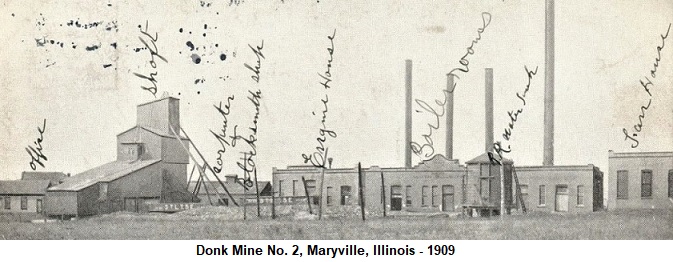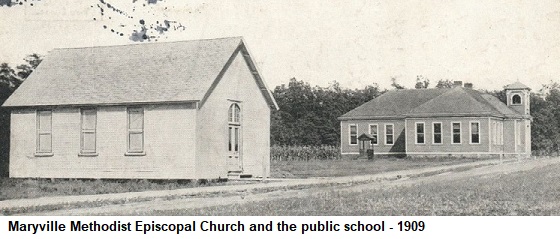Early History of Maryville
Recommended reading: The History of Maryville
The Founding of Maryville

Lange moved to Edwardsville in 1906. He divided his farm among his
children (although he retained the old homestead of 116 acres). He
became the director of the Bank of Edwardsville. Lange died April 7,
1926 in Edwardsville, and is buried in the St. John’s Lutheran
Cemetery in Maryville.
Stores, hotels, rooming houses, blacksmith shop, taverns, and other
businesses sprang up rapidly as the town of Maryville began to grow.
In 1902 there were four saloons, all run by village officials – Mike
Daly, Al Hrubetz, charley Fornero, and John Contratto. In October
1902, gasoline-fueled streetlights were installed.
Donk Brothers Coal and Coke Company
In 1902, the Donk Brothers Coal and Coke Company opened its Mine No.
2 in Maryville. The mine became one of the largest in the state,
employing 700-800 miners. As mine operations grew, stores, rooming
houses, a blacksmith shop, taverns (over a dozen at this point), and
other businesses were established. There was also a boarding house
for the miners. Most of the town’s revenue came from the taverns.
McCormick ran a restaurant along with the train station, which was
located in the far east side of the Hrubetz building (later the
Fireside Inn).
Progress
In 1903, the first post office was established, with William Mabbs
as postmaster. It was located in the Mabbs building, which was at
Main and Lange Streets (the present location of the Baptist Church).
In 1904, C.W.F. Lange sold four acres of land for $400, to
established the Fairland Cemetery. Prices were set at $10 per lot,
$2.50 per grave, and $4 for opening a grave.
In June 1905, a fire department was established. A No. 38 fire
engine with a 60-gallon steel tank was purchased. This was later
replaced by a pump engine. In 1928, the Volunteer Fire Department
began their annual homecomings. In 1939, they were able to purchase
their first fire truck. Building plans were started for the
construction of a public building. The two-story frame building had
a belfry, 4’ by 4’. The first public gathering in the new hall was
the Methodist Sunday School’s Christmas Eve program in 1905. In
1906, a public library was installed in the Village Hall.
In 1909, the first motion picture shows were offered by Louis Novero
on Main Steet. The children nicknamed the movie theater “Louis
Slate,” as a joke, as the theater had only boards to sit on.
The first electric lights in Maryville were installed in 1910, and a
public park was established in the northwest part of the village on
the car line. The park was named Buffalo Park. Joe Zajcek operated
refreshment stands and a dance hall in the park.
In 1912, the streetcar company erected a waiting room and express
office, and installed a potbellied stove at the intersection of Rt.
159 and Main Street. A platform was also built for loading and
unloading of goods. Ben Elsbecknear operated a tomato canning
factory with 12 employees, at what is now Rt. 159 overpass.
Maryville prospered until the closing of the mine in 1924 due to an
underground fire. The town then became a residential village, with
the title, “Whose Only Industry Was Baseball.” In 1931, with the
formation of the Inter-City League, Maryville was one of the
six-member clubs. Maryville won the league championship that year in
the playoffs. A number of young men at that time went on to play
professional and semi-pro ball – Dwain Sloat, Robert Boken, John
Lucas, Al Krupski, Walter Schuerbaum, Mike Semanisin, John Drost,
John Brussaiti, Charles Boken, Welsey Gronemeyer, George Govenat,
Lloyd Zarr, and Joe Garnero.
Early Schools in Maryville
On October 5, 1902, the first school in Maryville was established.
It was held in the second story of the Avetta building. Within a
short time, a new school building was constructed across the
railroad tracks, east of the Donk Brothers Coal & Coke Company mine.
An addition was made to the school as the village increased in
population. This schoolhouse was destroyed by fire on November 15,
1915. With the aid of Donk, a new school was constructed at the
present site of Donk Avenue, across from City Park.
Early Churches in Maryville
Churches began in Maryville as early as 1905, when Sunday School was
held at the City Hall. There was also a church near the first
school, which burned down in April 1920. A Catholic Church was
established in April 1938, and a Baptist Church was established in
1939. The Assembly of God Church was constructed in 1942, and St.
Luke’s Methodist Church was dedicated May 1956.

